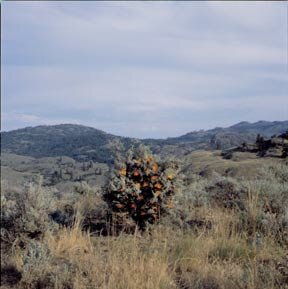Christopher Brayshaw
BURNING BUSH
REVIEWED BY CHRISTOPHER BRAYSHAW
Burning Bush
Kevin Schmidt
Artspeak Gallery
(through October 15, 2005)
The star of Burning Bush, Kevin Schmidt’s new video projection at Artspeak, is a fat clump of Okanagan sagebrush, tricked out like a miniature Christmas tree with tiny orange lights and flapping fabric “flames.” Behind it are dry sandy hills and a mackerel-colored sky which, over the quarter hour or so I watched, darkened ever so slightly, as if presaging rain.
The video’s subliminally punched-up ambient soundtrack – crickets peeping in the grass; the intermittent soughing of the wind – recalls the tranquil naturalistic moments bookending the country music video at the heart of Rodney Graham’s How I Became a Rambling Man (2000), as well as previous Schmidt projects like Fog, and, Chevrolet Caprice Classic Wagon…, whose alterations or hallucinatory intensifications of natural phenomena are metaphors for the artist’s ongoing investigations of the current critical relevance of landscape images.
Artspeak’s press release cites Schmidt’s projection’s genesis in Exodus 3, in which God appears to Moses in the guise of a burning bush. “And the angel of the LORD appeared unto him in a flame of fire out of the midst of a bush: and he looked, and, behold, the bush burned with fire, and the bush was not consumed.” The press release also claims that, “Schmidt’s work plays on contemporary interpretations of this myth and its cooption by Hollywood (as well as the Hollywoodization of the church in which sermons are held in vast movie theatres and stadiums while the live event is projected on the big screen).”
This language overreaches. Burning Bush is resolutely low-tech, plainly made with modest means. The projected image is muddy, lacking the crisp clarity of Fog’s medium-format slide projection. The “flicker fabric” lights were undoubtedly purchased over the counter at Home Depot or Canada Tire, and not from a professional effects company, as were many of the props and effects in, say, Geoffrey Farmer’s Contemporary Art Gallery installation The Blacking Factory (2002), an art work which explicitly references Hollywood production values and their dramatic alterations of reality.
Burning Bush’s accomplishment is far subtler. Its oscillating lights and shivering tongues of flame create a place of focus in what at first appears to be a totally still landscape. As your eye slowly probes the scene, you realize that everything captured by Schmidt’s camera is moving, albeit much more slowly than the bush. Nothing is fixed in place, not even the hills.
Nowadays in British Columbia, whole economies are built around experiencing landscape, erecting frames to clarify and condense scenes in ways amenable to attention spans conditioned by TV, Web, and instant messaging’s abbreviations of reality. “Extreme” sports like snowboarding, heli-skiiing, or trail biking are attempts to speed the landscape up, to make local mountains, forests and waterways seem as exciting as the ones that appear in music videos and on “reality TV.”
Schmidt’s projection offers an antidote: an extended narrative that lacks temporal compression. He consequently risks alienating viewers. Like all artworks whose making and viewing times are equal,Burning Bush eschews the dramatic incidents and narrative throughlines that may be required to sustain viewers’ interest in a projected work over a long duration.
The reward for pushing past the nagging sense of dissatisfaction that Burning Bush engenders is a kind of mental slippage, a shift down into a slower, more meditative kind of thinking. On the day I visited, Carrall Street was teeming with ferocious rain; an obnoxious cracked-out panhandler; buses turning; and drivers hydroplaning down the block. Things unfolded outside in a great rush; inside, it was still high Okanagan summer.
The difference between the gallery and the external world could not have been more distinct. I actually swayed when I stepped outside, a perceptual disconnect that I associate with some of Robert Smithson’s mirror sculptures, and an afternoon spent with Richard Serra’s Torqued Ellipsesin the Hudson Dia’s dim basement. Smithson’s and Serra’s subject is time, and how objects can concatenate it, folding it back on itself like a seashell’s whorls, or the fractal complexity of a sagebrush branch. Burning Bush testifies to these phenomenological investigations’ ongoing relevance to contemporary art; they speak in and through Schmidt’s project like the Angel of the Lord through Moses’ bush.
Christopher Brayshaw is an independent Vancouver-based critic, curator,and bookseller.

